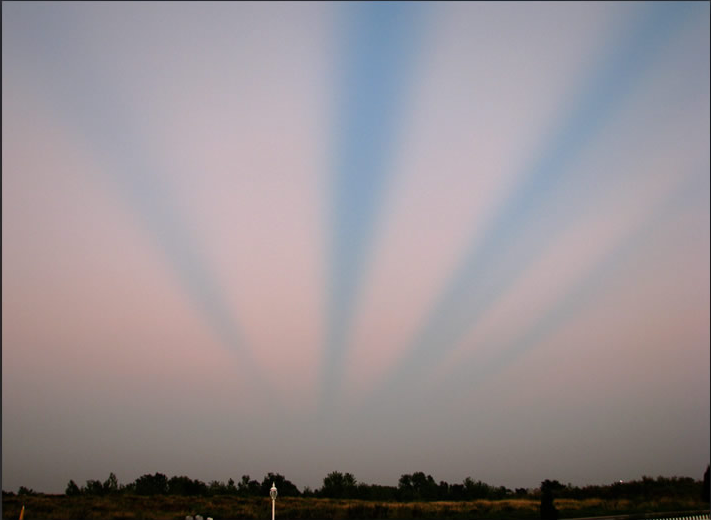Iowa rays
Iowa Rays: Exploring the Phenomenon of Anticrepuscular Rays
When it comes to atmospheric optics, one fascinating phenomenon that captures the imagination is the occurrence of "Iowa rays," also known as anticrepuscular rays. These breathtaking rays, observed by Rick Alexander in Fairfield, Iowa, provide a mesmerizing display of nature's beauty. In this article, we will delve deeper into the nature of these rays, their formation, and the potential factors that contribute to their appearance.
Anticrepuscular rays are produced by clouds in the western sky that cast shadows on the sun. Contrary to their appearance, these rays are parallel in nature. However, as they extend further into the distance, they seem to converge to a point directly opposite the sun's position. This convergence can be compared to the way roads or railroad tracks appear to converge when viewed from a distance.
One interesting aspect of these Iowa rays is the presence of deep sky colors that often accompany them. August seems to bring about unusual sunset skies over North America, and one possible explanation for this phenomenon lies in the recent eruptions of three stratovolcanoes in Alaska's Aleutian Islands. These volcanic eruptions inject significant amounts of dust and aerosols, including sulfur dioxide, into the stratosphere. As high altitude winds disperse these particles, they scatter sunlight and contribute to the creation of glorious sunsets, rays, and even Bishop's rings.
The injection of dust and aerosols into the stratosphere by volcanic eruptions is not a new concept. Throughout history, volcanic events have been known to have a profound impact on the Earth's atmosphere. The particles released during eruptions can linger in the stratosphere for extended periods, affecting atmospheric conditions and leading to stunning optical displays.
It is important to note that while volcanic activity can contribute to the appearance of Iowa rays and other atmospheric phenomena, it is not the sole factor responsible for their occurrence. Various atmospheric conditions, including the presence of clouds, the angle of the sun, and the observer's location, all play a role in determining whether one can witness these captivating rays.
The beauty of Iowa rays lies in their ephemeral nature. They appear during specific moments and under specific conditions, making them a rare sight to behold. Their transient existence serves as a reminder of the intricate interplay between light, clouds, and atmospheric dynamics that continually shape our environment.
In conclusion, Iowa rays, or anticrepuscular rays, are a mesmerizing atmospheric phenomenon that captivates both scientists and nature enthusiasts alike. These parallel rays converge as they extend into the distance, creating a breathtaking display that stretches across the sky. While volcanic eruptions can contribute to the appearance of these rays, various other factors determine their occurrence. Witnessing Iowa rays is a testament to the ever-changing nature of our atmosphere and serves as a reminder of the beauty that can be found in the play of light and shadow. So, keep your eyes to the sky and embrace the wonder of Iowa rays whenever they grace our horizons.

Anticrepuscular Rays seen by Rick Alexander close to sunset Friday 22nd August 08 at Fairfield Iowa. Image ©Rick Alexander, shown with permission.
The camera is pointing east. These rays, produced by clouds in the west shadowing the sun, stretched right across the sky to converge to a point directly opposite the sun's position. Anticrepuscular rays are of course parallel but converge as they get more distant in the same way that roads or railroad tracks do.
The deep sky colours are possibly another example of August's unusual sunset skies over North America. The recent eruptions of three stratovocanoes in Alaska's Aleutian Islands could be responsible. Volcanoes inject huge clouds of dust and aerosol forming sulfur dioxide into the stratosphere. High altitude winds spread the particles widely to scatter sunlight and produce glorious sunsets, rays and Bishop's rings.
Note: this article has been automatically converted from the old site and may not appear as intended. You can find the original article here.
Reference Atmospheric Optics
If you use any of the definitions, information, or data presented on Atmospheric Optics, please copy the link or reference below to properly credit us as the reference source. Thank you!
-
<a href="https://atoptics.co.uk/blog/iowa-rays/">Iowa rays</a>
-
"Iowa rays". Atmospheric Optics. Accessed on November 22, 2024. https://atoptics.co.uk/blog/iowa-rays/.
-
"Iowa rays". Atmospheric Optics, https://atoptics.co.uk/blog/iowa-rays/. Accessed 22 November, 2024
-
Iowa rays. Atmospheric Optics. Retrieved from https://atoptics.co.uk/blog/iowa-rays/.